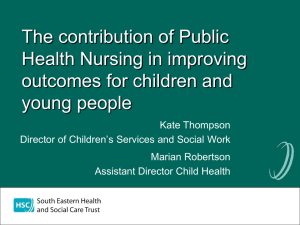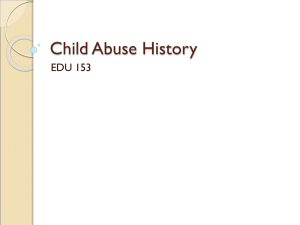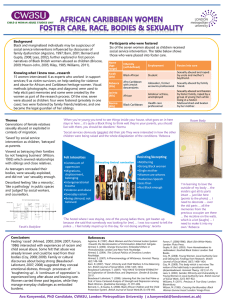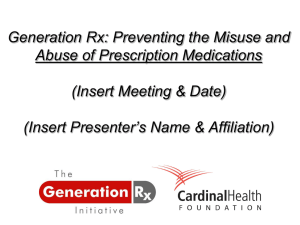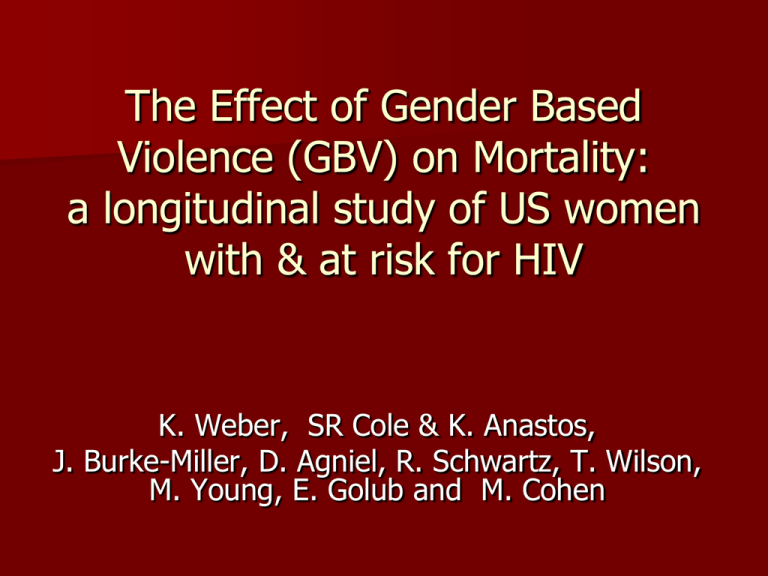
The Effect of Gender Based
Violence (GBV) on Mortality:
a longitudinal study of US women
with & at risk for HIV
K. Weber, SR Cole & K. Anastos,
J. Burke-Miller, D. Agniel, R. Schwartz, T. Wilson,
M. Young, E. Golub and M. Cohen
Background
GBV is a significant public health issue
with a high prevalence (24-78%) among
women with and at risk for HIV.
Studies have shown that abuse is
associated with reduced medication
adherence and poor treatment outcomes
among people with HIV
Study Objective
To determine the prevalence of recent
sexual, physical & emotional abuse & its
effect on mortality in women in the
Women’s Interagency HIV Study (WIHS),
largest on-going study of a representative
cohort of women with and at risk for HIV
in the U.S.
Methods
Included 2,222 (1642 HIV+/580 HIV-) women
enrolled during 1994 and 2001 at Chicago, DC,
Bronx and Brooklyn sites who had study visits
every 6 months for up to 12 years
Marginal structural modeling was used to
determine mortality risk & survival time
associated with recent abuse controlling for
sociodemographic, behavioral, & clinical
factors
Study Measures
Recent Abuse: self report in past year of forced
sexual contact, physical abuse/assault, and/or
emotional abuse including intimate partner
violence (IPV). IPV: threat to hurt/kill, prevent
from leaving/entering home, making phone
calls, meeting w/ friends, attending work/school,
or getting needed medical care
Outcome: All cause mortality & time to death
confirmed by National Death Index registry
matches
Baseline characteristics by survival status
Characteristic
Survivors
Deaths
(N= 1785)
(N = 437)
69%
34 (29, 39)
71%
94%
39 (34, 43)
77%
22%
30%
29%
67%
14%
65%
15%
72%
13%
76%
Education < HS
35%
43%
Depressive symptoms
47%
64%
HIV+ Serostatus
Age, Median (IQR)
History of Pre-WIHS
Abuse
Childhood Sexual
Abuse (CSA)
Race
White
African American
Other
Income < 18,000
Characteristic
Survivors
Deaths
Current Crack,
cocaine, heroin CCH)
CCH Ever
21%
35 %
53%
77 %
IDU Ever
22%
51%
Current Smoking
55%
70%
Smoking Ever
68%
83%
Transactional Sex
24%
40%
Hazardous Drinking
15%
21%
Partnered
38%
34%
Unstable Housing
19%
17%
CD4 Count, Median
426
209
Abuse exposure by study year, HIV status, and prior abuse
-History
of episodes
Abuse -72%;
new
-6%;
cumulative abuse -78%
2,450
abuse
reported
by abuse
794 (36%)
women
-2450 abuse events were reported by 794 (36%) of women during
the study period
Survival Curves by Current Abuse
1.0
Abuse in Past Year
1.0
Abuse inNo
Past Year
No Yes
0.9
Yes
0.9
0.8
Crude Survival
Crude Survival
0.8
0.7
0.7
0.60.6
0.50.5
0.4
0.4
0
0
2
4
2
4 Years of Follow-up
6
6
8
Years of Follow-up
10
8
12
10
12
Association of recent abuse with mortality
Current
Abuse
Unadjusted
Deaths
Personyears
HRa
95% CIa
No
392
16495
1
NA
Yes
45
1682
Baseline-Adjusted b
1.16
1.17
0.84, 1.60
0.84, 1.64
Fully-Adjusted c
Weighted c
Weighted, trimmed d
1.13
2.07
1.54
0.79, 1.60
1.66, 2.57
1.18, 2.02
a
HR, hazard ratio; CI, confidence interval
b Adjusted for baseline variables: Study Site, HIV Serostatus, Age, Race, Income, Education, History of Pre-WIHS
Abuse, Childhood Sexual Abuse, Health Care Utilization, CES-D Score, Cognitive Function, Drug Use, Smoking
Status, Having a Partner, Unstable Housing, Transactional Sex, Hazardous Drinking, Viral Load, CD4 Count,
Nadir CD4 Count, HAART Use, Non-adherence
c Adjusted (or weighted) for baseline and time varying variables: Study Site, HIV Serostatus, Age, Race, Income,
Education, History of Pre-WIHS Abuse, Childhood Sexual Abuse, Health Care Utilization, CES-D Score, Cognitive
Function, Drug Use, Smoking Status, Having a Partner, Unstable Housing, Transactional Sex, Hazardous
Drinking, Viral Load, CD4 Count, Nadir CD4 Count, HAART Use, Non-adherence
d Weighted trimmed at the 0.1 and 10
Conclusions
In this longitudinal study, marginal
structural modeling allowed us to estimate
the causal effect of recent abuse on
mortality
Lifetime prevalence of abuse in women in
this study is 78%; one third of women in
WIHS reporting recent abuse during our
study observation
Women who experienced recent abuse
were nearly twice as likely to die than
those who did not experience abuse
Implications
Since recent abuse reduces survival in women
with HIV, identification of current abusive
episodes and provision of interventions are
needed to reduce mortality.
Provide resources to design, test and utilize
innovative interventions to prevent GBV and
treat those affected by GBV
Future research into identifying the causal
pathway linking abuse to mortality is needed
What is needed
Research into how intimate partner abuse
and childhood sexual abuse affect the
immune system may help explain why
trauma seems to be associated with
increased morbidity and mortality in HIV
and other diseases.
Health care systems need to integrate and
improve violence screening and referrals
to keep women safe and alive.
Addressing family and community level violence
including a no tolerance approach can change
the culture of violence.
Gender equity, reducing poverty, increasing
education opportunities and women’s
empowerment are needed to challenge current
structural violence
A national sustainable plan is needed to ensure
that women with and at risk for HIV are safe
and continue to benefit from treatment
advances.



